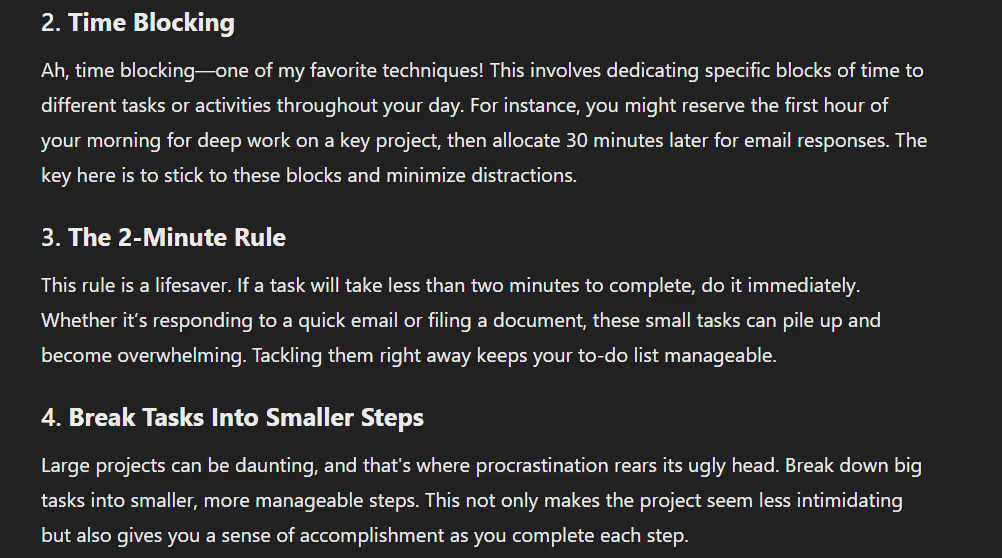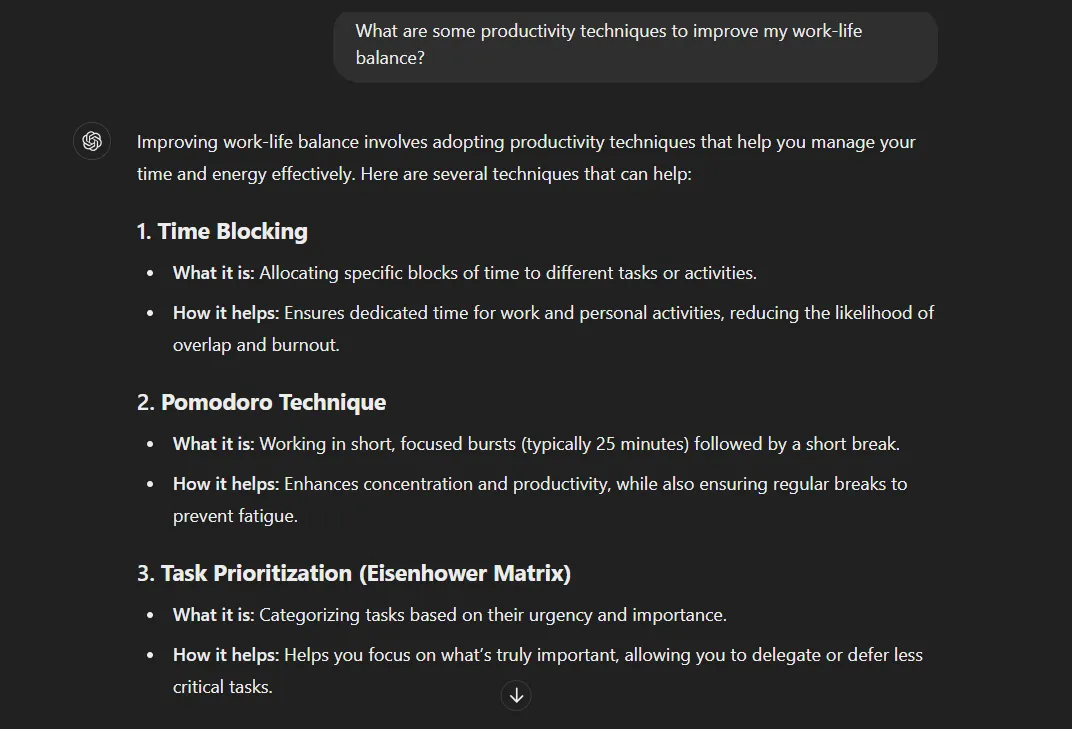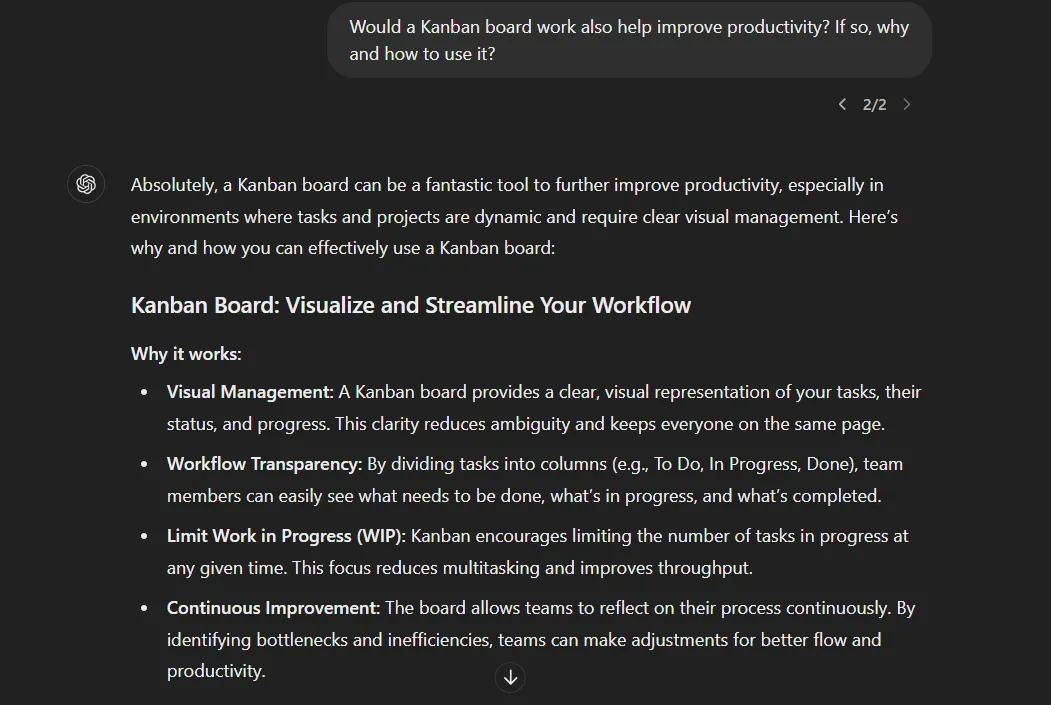Making ChatGPT sound human is mostly about using descriptive language in your prompts — poor input leads to poor output.
You must instruct it to follow a specific persona and include a few details about your audience so you can get more human-like text responses.
Ideally, you should include your existing text samples to help it follow your style.
But that's only one part of the fix.
To make ChatGPT-generated content effective, you'll also need some editing. This post covers everything you need to make ChatGPT sound more human.
What you will learn:
- Why it's important to make ChatGPT's responses sound more human.
- How to use specific personas, writing samples, and details about your audience to get better responses.
- Why it's important to build an outline first
- How to edit the generated text to sound like a real person wrote it
- The importance of fact-checking and proper text formatting.
Why is it important not to sound like AI?
It's important to not sound like AI because AI-generated content influences the perceived quality and authenticity of a piece of content. Human writing is often considered to be more authentic than AI-generated content.
This could be because a human writer puts in more time and effort when writing versus clicking a button to churn out content with an AI writing tool.
Modifying AI-generated content to make it sound more human-like helps avoid detection from Google and maintains your brand's unique tone of voice. It also improves the quality of the generated content and reading experience.
Although certainly useful, AI writing tools like ChatGPT may not be the best copywriters out there.
They typically adopt overly formal language, use passive voice a lot, and love cliches like "delve into" or "navigate the complexities of," for example.
These tendencies often make AI-generated content bland and hard to read, and can also leave a poor impression on your readers.
As per Bynder's survey examining human attitudes towards AI vs humanized content, 50% of respondents can tell if the content is AI-generated.
If you leave the content as is, some readers might interpret that you didn't put the time and effort necessary to create authentic, helpful posts — that's obviously not a good look.
9 steps to make AI tools like ChatGPT write like humans
With some fine-tuning and some intervention from your end, AI-generated content can sound just as natural as human-written posts but in a fraction of the time.
Here are 9 easy steps on how to make AI write like a human.
1. Explain who you are
Tell ChatGPT to adopt a specific persona in your prompts. This helps it adjust its writing style and tone of voice based on that character.
The more specific, the better — give your persona a name, an age range, a few personality traits, and any other biographical information that will help your AI tool write from that persona's perspective.
For ChatGPT to sound like a human, it must think like a real person.
Here's an input example of a prompt.
"Please write from the perspective of Sarah, a 35-year-old productivity coach based in New York City. Sarah has over 10 years of experience helping professionals optimize their work routines. She is known for her practical advice, friendly tone, and focus on actionable steps. Use a conversational and supportive tone that reflects Sarah's approachable personality."

And here's the AI content output.

This practice is especially useful for making ChatGPT sound more on-brand like a human copywriter.
If you have a brand persona set up, simply plug it into your prompts and the AI-generated responses will write in a tone for that ideal reader.
You can also save these details directly in your ChatGPT account, so you don't have to repeat yourself in each prompt.
To do this, click on your profile icon on the top-right corner of the screen and select Settings > Personalization >Customize ChatGPT.
Then type in all the relevant details that will help ChatGPT's responses match your desired tone and style.

ChatGPT will then use these details to provide more relevant responses in future conversations.
2. Teach ChatGPT your writing style
Another way to guide AI tools to provide human-like text responses is by showing it samples of your existing texts.
This lets the AI writer identify and replicate recurring themes in your tone, vocabulary, and sentence structure — whether you use short or long sentences, formal language or slang words, particular terminologies, and so on.
Having ChatGPT imitate your style will also make it less likely for readers to pick up that the content is AI-generated.
You can plug one of your text samples and tell ChatGPT to mimic these factors in your prompts, just like this:
"Use the text below to write an article on the topic: [Your topic]. Use the same style, phrasing and tone from this text in your response."
Ideally, your text sample should be around 500 words.
This gives the AI language model enough room to identify patterns in your text and replicate them more accurately.
If the AI writer can sound like, you, it will create more human like output.
3. Explain who the audience is
Specifying who your target audience is in your prompts gives the language model further context on what style and tone it should adopt while you get to spend less time editing the output.
You can also couple it with the personas I showed above.
Let's go back to the Sarah example, but also offer a few details about our audience this time.
Here's the additional input.
“The audience who will read this are tech-savvy young adults aged 20-35, primarily based in urban areas who enjoy gaming and digital media. They are looking for efficient ways to balance work and personal life through productivity hacks.”

And here's the output.

The new output mostly discusses the same points as the previous example, but it uses much more conversational language—it even includes some slang words.
Notice the difference in the language of the third point, "the two-minute rule," between the two outputs when we provide the target audience.
Previous [without providing a target audience]
"This rule is a lifesaver. If a task will take less than two minutes to complete, do it immediately"
Now [with target audience details]
"Got a task that can be done in two minutes or less? Do it immediately."
The lighter tone is more likely to resonate with our provided target audience of young tech-savvy readers.
Just like personas, make sure to provide specific details about your audience. Briefly include their demographics, hobbies, and pain points.
This ensures ChatGPT's responses don't feel robotic and makes it more likely to provide valuable insights regarding your audience's particular needs.
And again, you can save these details in the Custom Instructions box.
4. Build customized outlines
Outlines help plan your main discussion points ahead of time and ensure your content provides in-detail coverage of the topic in question.
They also prevent you from veering off subject during the writing process.
Having AI writers generate content based on existing outlines can ensure that your output provides valuable information and not generic material.
Of course, if you don't want to build outlines yourself from scratch, you can generate them with AI and then build on your content from there — but be careful.
Simply asking AI copywriting tools like ChatGPT to build an outline on a particular topic will most likely lead to vague structures and discussion points that won't give your content much direction.
Here's an example of a bad prompt for an outline.

Instead, you should use the prompts to ask leading questions about your main topic. This will nudge the AI's output to provide more relevant responses.
You can then include ChatGPT's answers in your outline prompt.
Sticking with the example above, here's what happens if I type in "What are some productivity tips to improve my work-life balance?" instead:

The output is now much more specific.
I could use these details to refine my original prompt and piece together a solid outline — just like this:

Remember, AI writers can make mistakes too — just like humans.
Do your own research and check to see if the generated outlines are accurate and provide information relevant to your main topic.
Here's an effective prompt to use when generating content outlines from ChatGPT.
"Write an outline for the headline [your header] with bullet points. Add 3-5 talking points under each header. Be detailed and instructional in your talking points. Assume you are instructing a novice writer who needs specific direction and has to be told exactly what to write about. Remember, you are writing an outline, so the talking points under each header must be instructions, not explanations. For example, ask the writer to explain, discuss, or expand on the points under each header by providing clear instructions in full sentences or paragraphs. Don't use the phrase "instruct the writer to."
5. Use detailed prompts to generate content
AI generated responses largely depend on your instructions — vague input equals vague output.
Your prompts must be as specific as possible when asking ChatGPT to write content.
Instruct them to expand on each heading and bullet point within your outline. This prevents the AI model from providing generic information or going off-topic.
For example, here's how I used all the details we discussed above to craft a descriptive prompt that instructs ChatGPT to build a blog post via the generated outline.

And here's part of the output:

Instruct the AI generator to stick to a specific word count — it still might go above it, but it's a simple trick to avoid excessive fluff in short-form content.
If you want to generate longer content, you can ask extra questions related to your topic and add the answers to your post if they make sense.
In this particular case, a question like "Would a Kanban board also help improve productivity? If so, why and how to implement it?" can add extra relevant information.

6. Humanize AI Content
You must treat AI-generated content more like drafts that require human intervention, not as finished content.
As mentioned, AI tools tend to go heavy on cliche terms, which are easy to pick up by both AI detectors and readers.
Your job is to spot complex language and rewrite it to make your content sound more human.
Here's a brief list of words and phrases AI tools particularly like to use:
- "In today's digital age," "in this fast-paced era."
- "Delve into," "embark on a journey," "take a dive into."
- "Elevate," "evoke," "unlock."
- "In conclusion," "in summary."
You can find more overused terms on this Reddit thread.

It's good practice to look for terms that sound unnatural in normal everyday language.
AI tools may also write in passive voice.
It's best to rewrite passive sentences into active voice. Here's a quick example:
- Passive voice: "The article was edited by him."
- Active voice: "He edited the article."
Active voice helps remove unnecessary words and make your text easier to read and more human-like.
Of course, this process might take a few hours if you do it manually.
But tools like Surfer's AI Content Humanizer can reduce the rewriting process to just a couple of minutes. Simply copy the content from your AI content generator, paste it into the window, and Surfer will convert it into human-like text.

Surfer's AI detection algorithm is trained on both human-written and AI-generated content. As such, it can spot AI-specific patterns in vocabulary, syntax, and sentence structure, and then modify these to mimic human conversation.
7. Add experience, statistics, and examples
Although Google states it has nothing against AI-generated content — as long as it provides genuinely helpful information — Google rewards content that adheres to its E-E-A-T guidelines.
In other words, Google prioritizes content that demonstrates Experience, Expertise, Authority, and Trust. The problem is that AI-generated texts cannot fulfill these criteria all by themselves—they need a personal touch.
To satisfy Google's Experience and Expertise part, complement AI text with your personal stories, examples, and insights about a specific topic just like what Budget Travel With Gaby does here:

This blog post about things to do in Switzerland includes the author's own stories and experiences through phrases like "We stayed at the Mattenhof Hotel" or "I also enjoyed a decadent dinner."
She also demonstrates her expertise in the introduction.
For example, "I helped lead a weekend trip to Interlaken" clearly shows readers she is qualified to share the tips mentioned in the blog post.
Incorporating first-person pronouns like "I," "we," and "my" is also a clever way to appeal to Google's E-E-A-T guidelines and simultaneously make your content more engaging and follow a conversational tone.
For more technical content, make sure to back up your statements with relevant statistics or case studies.
This can help satisfy the Authority and Trust factors.
For example, simply saying "People spend a significant amount of time on social media each day" isn't good enough.
Although probably true, the statement doesn't provide any quantifiable insights.
Including statistics to back the AI tool's statements can help solidify your point. You can easily add relevant data to your blog posts by typing "[your keyword] + statistics" in the search bar.
AI writing assistants like Surfy can also automate tasks like this for you. Here I'm asking Surfy to find a statistic and link to the source without leaving the editing window.

Here's the output.
"Social media usage has become a significant part of our lives. According to a Global Web Index study, people spend on average 2 hours and 34 minutes on social media each day."
Isn't this much better?
The statement now has a lot more weight to it and helps make your content more credible.
8. Add formatting and images
No one likes to read through huge blocks of text.
Break up AI-generated content into multiple paragraphs to keep your blog's structure neat and easy to read.
Double-space your paragraphs to add white space and improve content readability.
As a general rule of thumb, stick to one idea per paragraph — two to four sentences for each paragraph. This also helps emphasize your ideas and make them more memorable.
Here's how Bit.ly formats its blog posts:

The paragraphs are short and sweet.
The blog also uses bullet points and emboldened texts to highlight important snippets of information further.
And don't forget about images.
They help provide context and improve readability as long as they add value to your content.
Avoid stock images. They are perceived as superficial and will not do your blog post any favors but you can use AI generated images to depict abstract concepts that may not have substitutes.
Don't be afraid to include images that you may own.
Readers want to see authenticity, and adding real-world images will increase your chances of appearing close to human-like output.
Add visuals like infographics and charts that back up your ideas.
Sticking with our Chat GPT-generated post, the Pomodoro technique would take a while to explain with pure text.
An illustration here would be more than welcome.
Just like this.

You can also use visuals to showcase different examples and add extra context to your content, just as I did throughout this post.
9. Fact-check your AI article
AI can also make factual errors.
It compiles information from all over the web, as well as its training data, some of which may not be accurate.
As it turns out, that snippet of information was pulled from a satirical Reddit post from 11 years ago. Check out this X thread for more details.
Fact-checking your AI content is a must or you may risk hindering your overall reputation and credibility. Irrespective of whether you're using essay writing apps for university, or AI writers for SEO content, review the text.
Do your own research before you generate the article. This will help you familiarize yourself with the topic, which makes it easier to spot potential errors.
Link your content to reputable sources to let readers fact-check the information themselves.
Also, check for plagiarism to avoid any issues because AI tools can sometimes pull information from a specific source word for word.
Generating AI content with Surfer
You can use Surfer AI to draft your first version and then edit it using the tips I've shown in this article. For example, writing an article on improving time management only requires you to enter the main keywords you're targeting.
- Enter between 1-5 primary keywords
- Select your country and device preferences
- Click the Create button
You'll then have the option of selecting competitiors, your preferred tone of voice and the blog post format, before Surfer generates an article that looks like this in about 20 minutes.

You can then humanize the content to make AI text sound like a human writer.
Key takeaways
- Making ChatGPT sound human is important to avoid detection by search engines and putting readers off.
- For ChatGPT responses to be more accurate and more human-like, be descriptive in your prompts — adopt a specific persona, offer a few details about your audience, and provide existing writing samples.
- Use AI tools to build an outline before generating the content itself — it helps AI generators provide more specific information and prevents them from going off-topic.
- Edit AI-generated content by incorporating first-person pronouns, active voice, and following a conversational tone — it helps give your content a more natural flow.
- Add personal insights, experiences, and examples to boost credibility. Include statistics from reputable sources.
- Add images, and proper formatting to increase readability.
- Always fact-check AI content to avoid misinformation.


.avif)


